| View previous topic :: View next topic |
| Author |
Message |
Roger Warin

Joined: 23 Jan 2013
Posts: 1248



|
 Posted: Sep 23, 2013 10:16 Post subject: Collection of Giuseppe Cesāro (1849 - 1939) Posted: Sep 23, 2013 10:16 Post subject: Collection of Giuseppe Cesāro (1849 - 1939) |
|
|
Giuseppe Raimondo Pio Cesāro
Naples 1849 - Comblain-au-Pont (Ličge) 1939.
Cesaro was professor of crystallography and mathematics at the Ličge University (Belgium) in 1895. He succeeded Gustave Dewalque.
He was also the tutor of mathematics of the future King Leopold III.
He was a friend of Alfred Lacroix (MNHN Paris), Georges Friedel (University of Strasbourg), vom Rath (University of Bonn) ...
He was a great crystallographer. He discovered (1887) the isocelohedron "L" (or hexagonal dipyramid) on calcite crystals of Rhisnes mine, very rare as dominant form for this mineral.
Roger.
| Description: |
Calcite
Rhisnes, Namur Prov., Belgium
11 cm wide
Dipyramid L {88.3} (dominant)
Rhombohedron {10.1} (top) |
|
| Viewed: |
24776 Time(s) |
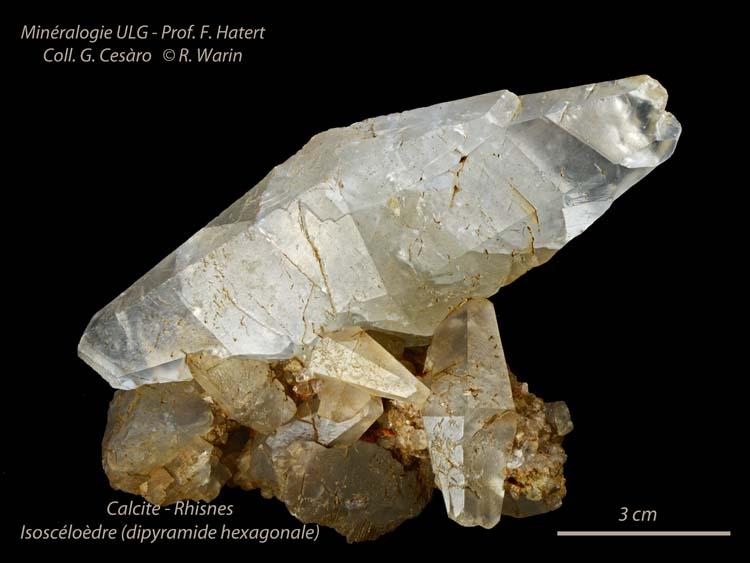
|
|
|
| Back to top |
|
 |
Jordi Fabre
Overall coordinator of the Forum

Joined: 07 Aug 2006
Posts: 5092
Location: Barcelona



|
 Posted: Sep 23, 2013 10:44 Post subject: Re: Collection of Giuseppe Cesāro (1849 - 1939) Posted: Sep 23, 2013 10:44 Post subject: Re: Collection of Giuseppe Cesāro (1849 - 1939) |
|
|
Dear Roger,
I love this thread as well as the other thread: Collection of H. UNGEMACH (1882 - 1936). You are doing a great job retrieving our patrimony, the mineralogical memory.
Please more!
_________________
Audaces fortuna iuvat |
|
| Back to top |
|
 |
Roger Warin

Joined: 23 Jan 2013
Posts: 1248



|
 Posted: Sep 23, 2013 16:17 Post subject: Re: Collection of Giuseppe Cesāro (1849 - 1939) Posted: Sep 23, 2013 16:17 Post subject: Re: Collection of Giuseppe Cesāro (1849 - 1939) |
|
|
This message is especially for beginners.
Rhisnes is a magical place for the crystallographer. Fortunately, a great crystallographer, Cesāro, was present. Otherwise all these limestones have ended their lives in a lime kiln. This happened in the late 80s (in the 19th century).
Nature not only gave its hexagonal dipyramide in Rhisnes quarry but also several generations of growth have modified the crystals of calcite.
Thus, it is very often a second crystal grows on the first. While most of the time, this second crystallization is deposited randomly on the crystal, in this case, it is built on the foundations of the first. The plans of the Great Architect (Nature) have been met. In other words, the lattice remains unique. We have only one crystal. We say in this case that the growths are made along parallel axes.
Let us describe the specimen pic.
The primary crystal is a hexagonal dipyramid L {88.3}.
Then a second crystal is grafted. This one is a classic calcite composed of d2 {21.1} forms, i.e. the usual scalenohedron. This is modified by the e2 {10.0} prism, by the rhombohedron e3 {40.1} and also by L.
This photo shows a parallel growth.
Roger.
| Description: |
Calcite
Rhisnes, Namur Prov., Belgium
parallel growth on hexagonal dipyramid |
|
| Viewed: |
24660 Time(s) |
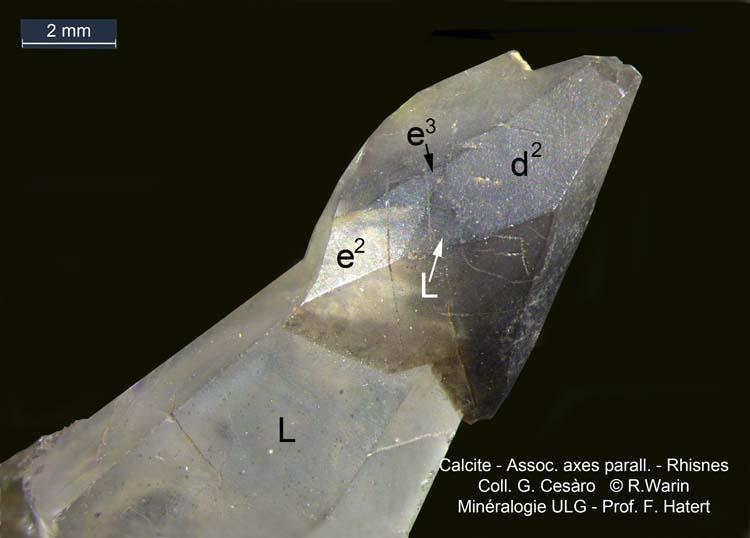
|
|
|
| Back to top |
|
 |
Roger Warin

Joined: 23 Jan 2013
Posts: 1248



|
 Posted: Sep 23, 2013 23:27 Post subject: Re: Collection of Giuseppe Cesāro (1849 - 1939) Posted: Sep 23, 2013 23:27 Post subject: Re: Collection of Giuseppe Cesāro (1849 - 1939) |
|
|
About the second crystallization, we can see a Buttgenbachs drawing of a similar calcite from Rhisnes, except that the form Φ {25 8 -25 3} is absent.
Ref.: H. Buttgenbach, Les Minéraux de Belgique et du Congo belge (1947).
When hexagonal dipyramids (as L) are secondary forms poorly marked, they are more difficult to identify without goniometric measurement.
Roger.
| Description: |
Calcite
Rhisnes - Namur Prov., Belgium
Drawing of the 2d Crystal (photo) |
|
| Viewed: |
24552 Time(s) |

|
|
|
| Back to top |
|
 |
Roger Warin

Joined: 23 Jan 2013
Posts: 1248



|
 Posted: Sep 25, 2013 06:19 Post subject: Re: Collection of Giuseppe Cesāro (1849 - 1939) Posted: Sep 25, 2013 06:19 Post subject: Re: Collection of Giuseppe Cesāro (1849 - 1939) |
|
|
This aesthetic group of calcite (Rhisnes) was studied by Cesāro.
You can admire the thoroughness of Cesāro, witness of a lost past.
A priori, this set is trivial, yet analysis yields amazing results.
It results from the assembly of three successive crystalline formations. A large variety crystallographic forms in calcite is possible.
Calcite is probably the mineral that can be modified by the largest number of forms. There are even exceptional Miller indices with values that appear in opposition to the rule of Millers rationality of indices.
PS: The letters correspond to the Haüy-Levys notation.
L : {8 8 . 3}
p : {10.1}
d2 : {21.1}
e3 : {40.1}
S : {19 10 . 6}
b5 : {41.6}
U: {33 5 . 1}
u : {62.1}
u : {62.1}
The label is a report.
Roger.
| Description: |
Calcite
Rhisnes, Namur Prov., Belgium
3 generations |
|
| Viewed: |
24414 Time(s) |
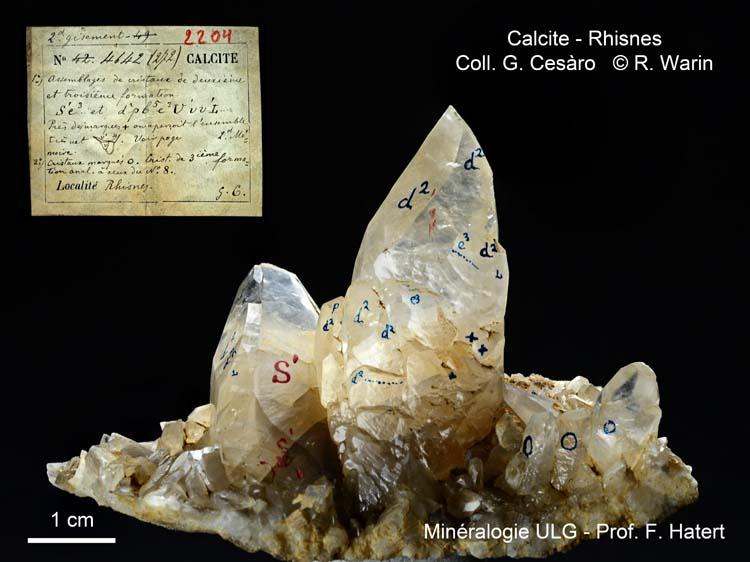
|
|
|
| Back to top |
|
 |
Martin Rich

Joined: 15 Aug 2013
Posts: 127
Location: Lower Austria



|
 Posted: Sep 25, 2013 19:14 Post subject: Re: Collection of Giuseppe Cesāro (1849 - 1939) Posted: Sep 25, 2013 19:14 Post subject: Re: Collection of Giuseppe Cesāro (1849 - 1939) |
|
|
| Roger Warin wrote: | ....calcite from Rhisnes, except that the form Φ {25 8 -25 3} is absent....
Roger. |
Roger, I love Calcite, crystallography and historical specimens! I read this thread with interest.
One question: should Φ in Miller indices conform with {25 8 -33 3}?
Martin
_________________
We are living on the matrix. |
|
| Back to top |
|
 |
Roger Warin

Joined: 23 Jan 2013
Posts: 1248



|
 Posted: Sep 26, 2013 00:25 Post subject: Re: Collection of Giuseppe Cesāro (1849 - 1939) Posted: Sep 26, 2013 00:25 Post subject: Re: Collection of Giuseppe Cesāro (1849 - 1939) |
|
|
Dear Martin
Of course the third indice is -28. My finger must have slipped on the numeric pad and as my sight is failing a bit, I have not seen this error.
Sorry for the mistake. Thank you for the report.
I like to illustrate by photos some basic facts that were taught to me at the university there very long.
As I have the opportunity to perform a photographic update of the collection of the Liege Mineralogy Lab, I found the specimens studied by Cesaro, Levy, Ungemach, Buttgenbach, Melon ... Surprises are great when sometimes the mineral is very small then the drawing in the textbooks is 5 or 10 cm wide.
Roger.
|
|
| Back to top |
|
 |
Roger Warin

Joined: 23 Jan 2013
Posts: 1248



|
 Posted: Sep 28, 2013 10:47 Post subject: Re: Collection of Giuseppe Cesāro (1849 - 1939) Posted: Sep 28, 2013 10:47 Post subject: Re: Collection of Giuseppe Cesāro (1849 - 1939) |
|
|
Hi,
Still a short lesson for the beginner, with a specimen of the ULG museum.
A hexagonal dipyramid can have only a trigonal symmetry. This is the case of calcite. The crystal class has a threefold axis vertical. It is for this reason that the endings are often rhombohedra. The crystal is based on a rhombohedral lattice. There is no mirror plane perpendicular to the 3-fold axis (the 3-fold rotoinversion axis).
The calcite crystal photographed shows the main form (hexagonal dipyramid) terminated by the rhombohedral {10.1}.
In a non-twinned crystal, so there is no horizontal mirror plane.
But in the twinned crystal, it appears a typical upper symmetry of the twin. The composition plane is horizontal and it becomes a pseudo-plane of symmetry. The upper part is symmetrical versus the lower.
The cleavage planes will be reflected in the mirror. In addition, the upper rhombohedral termination also becomes symmetrical to the bottom one.
This is the case of this Rhisnes calcite (L {88.3} and {10.1}).
A note on the label, it says "hémitropie sur a1." This is an old French word to emphasize the twin on (00.1).
Definition of hemitropy: Special crystals consist of two halves joined together regularly, but reversed from their normal position, as if one had made a half turn on each other.
Roger.
| Description: |
Calcite
Rhisnes - Namur Prov., Belgium
Twinned hexagonal dipyramid |
|
| Viewed: |
24031 Time(s) |
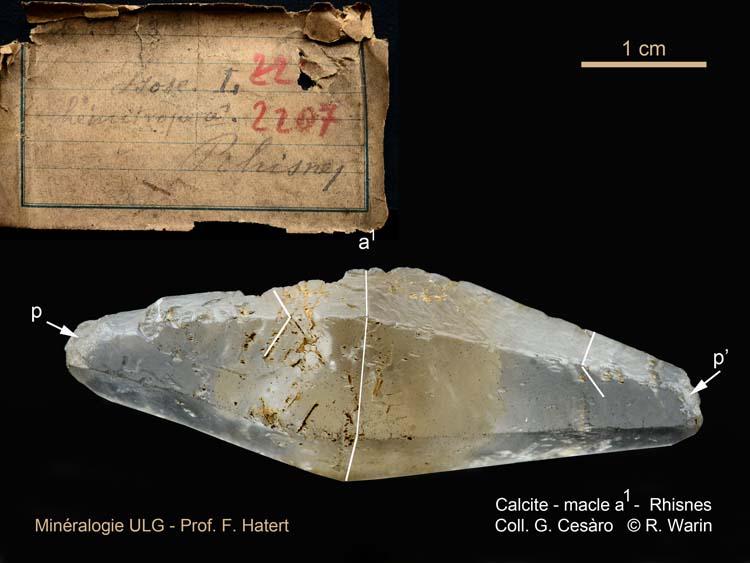
|
| Description: |
|
| Viewed: |
24013 Time(s) |
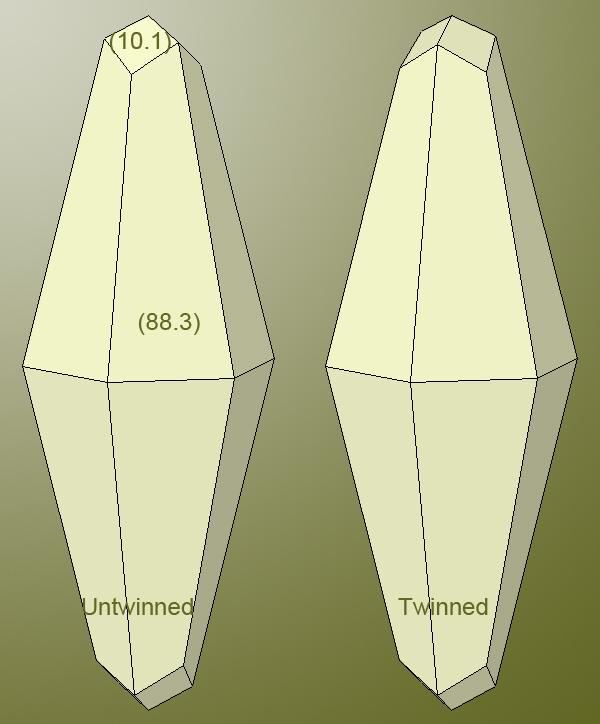
|
|
|
| Back to top |
|
 |
Roger Warin

Joined: 23 Jan 2013
Posts: 1248



|
 Posted: Jan 28, 2014 17:22 Post subject: Re: Collection of Giuseppe Cesāro (1849 - 1939) Posted: Jan 28, 2014 17:22 Post subject: Re: Collection of Giuseppe Cesāro (1849 - 1939) |
|
|
Hello,
Giuseppe Cesāro was a Belgian crystallographer of Italian origin (1849-1939). Reached in Liege 18 y. old, he was professor of crystallography at the University of Ličge from 1891 to 1921. His scientific work was well known and he performed an important role during the birth of the Union Miničre du Haut Katanga (Congo) (actually Umicore group) with his disciple Henri Buttgenbach.
He studied this remarkable galena from Freiberg (Saxony) and there he has discovered a new crystal form, the {551} trioctahedron.
Roger.
| Description: |
Galena
Freiberg, Saxe, Germany
4.3 cm
Discovery of the {551} trioctahedron. |
|
| Viewed: |
22886 Time(s) |

|
| Description: |
Galena
Freiberg, Saxe, Germany
Drawing of this galena # 104 |
|
| Viewed: |
22761 Time(s) |
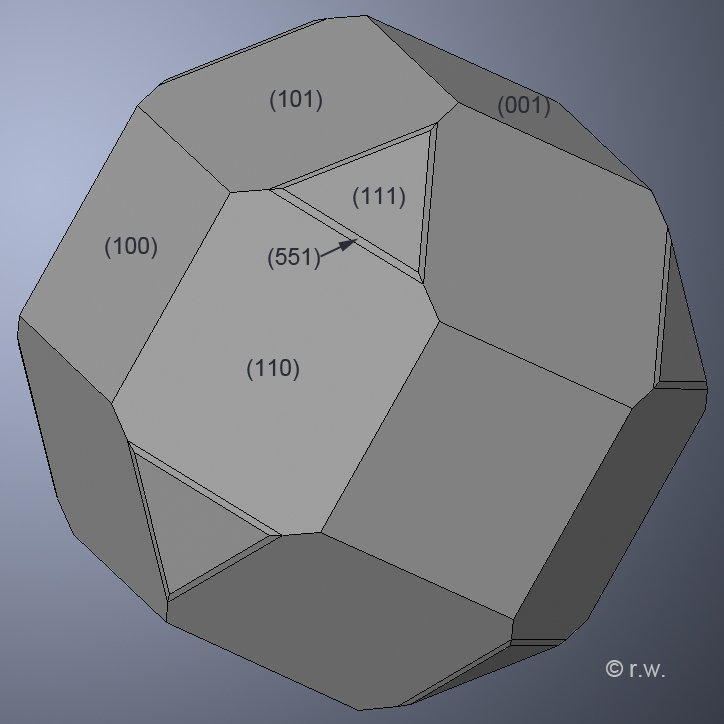
|
|
|
| Back to top |
|
 |
Roger Warin

Joined: 23 Jan 2013
Posts: 1248



|
 Posted: Feb 10, 2014 04:55 Post subject: Re: Collection of Giuseppe Cesāro (1849 - 1939) Posted: Feb 10, 2014 04:55 Post subject: Re: Collection of Giuseppe Cesāro (1849 - 1939) |
|
|
Galena # 3296
An exotic trapezodron in galena from Freiberg (Saxony).
{001}, {111}, {744}.
Roger.
| Description: |
Galena
Freiberg, Saxony, Germany
Unusual trapezoherdon {744} |
|
| Viewed: |
22614 Time(s) |
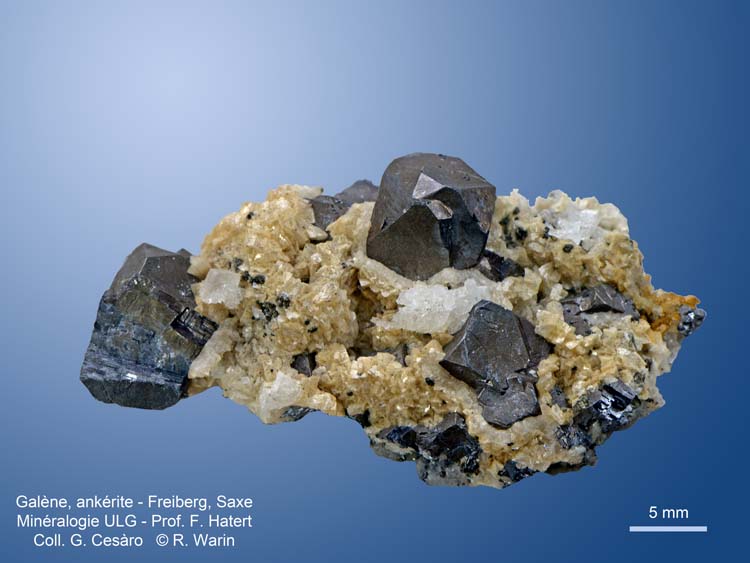
|
| Description: |
Galena
Freiberg, Saxony, Germany |
|
| Viewed: |
22618 Time(s) |
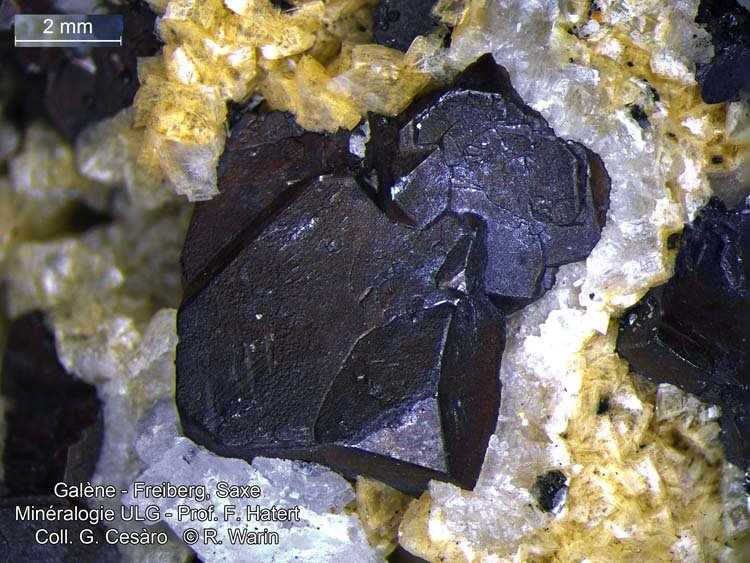
|
| Description: |
Galena
Freiberg, Saxony, Germany |
|
| Viewed: |
22754 Time(s) |
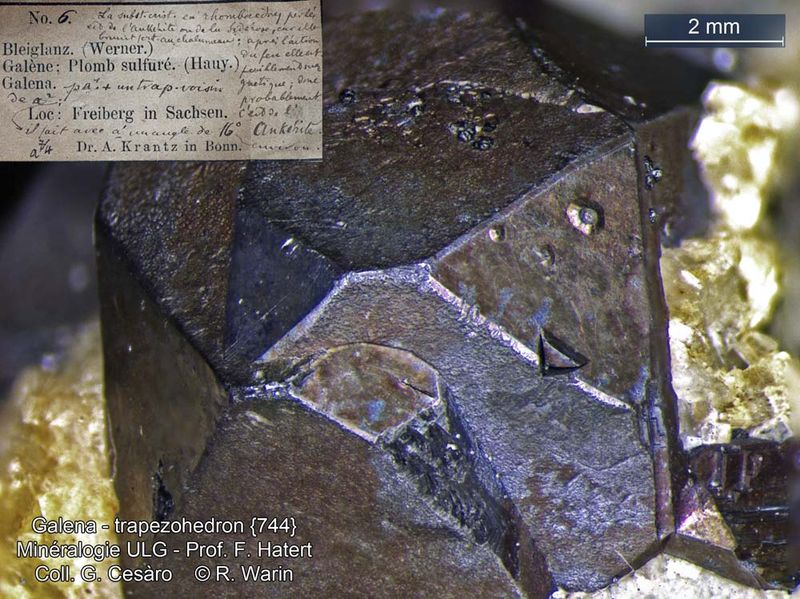
|
| Description: |
|
| Viewed: |
22627 Time(s) |
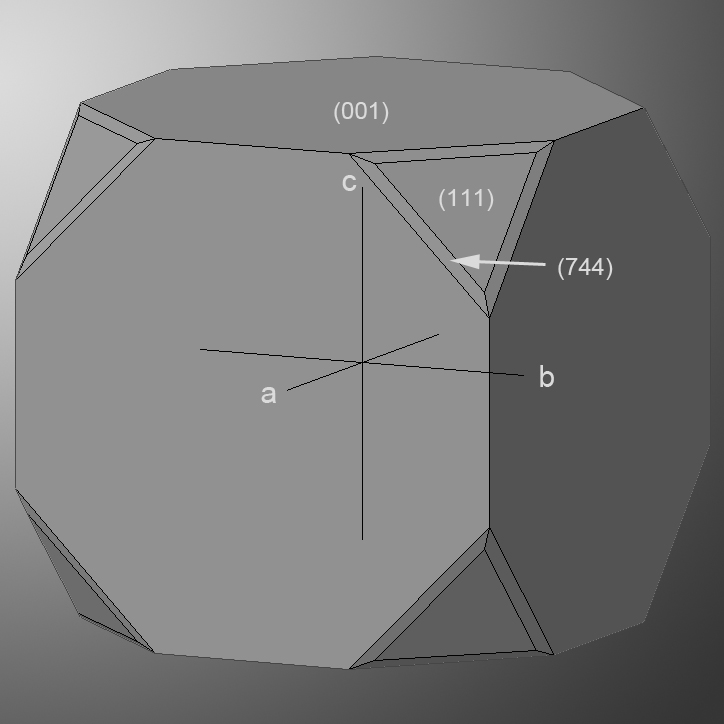
|
|
|
| Back to top |
|
 |
Roger Warin

Joined: 23 Jan 2013
Posts: 1248



|
 Posted: Feb 22, 2014 16:56 Post subject: Re: Collection of Giuseppe Cesāro (1849 - 1939) Posted: Feb 22, 2014 16:56 Post subject: Re: Collection of Giuseppe Cesāro (1849 - 1939) |
|
|
Hi,
Galena pseudomorph of pyromorphite.
Kautenbach mine near Bernkastel, Rhineland-Palatinate, Germany.
Roger.
| Description: |
Galena
Kautenbach Mine, Bernkastel, Rhineland-palatinate, Germany
23 mm
galena pseudomorph of pyromorphite. |
|
| Viewed: |
22410 Time(s) |
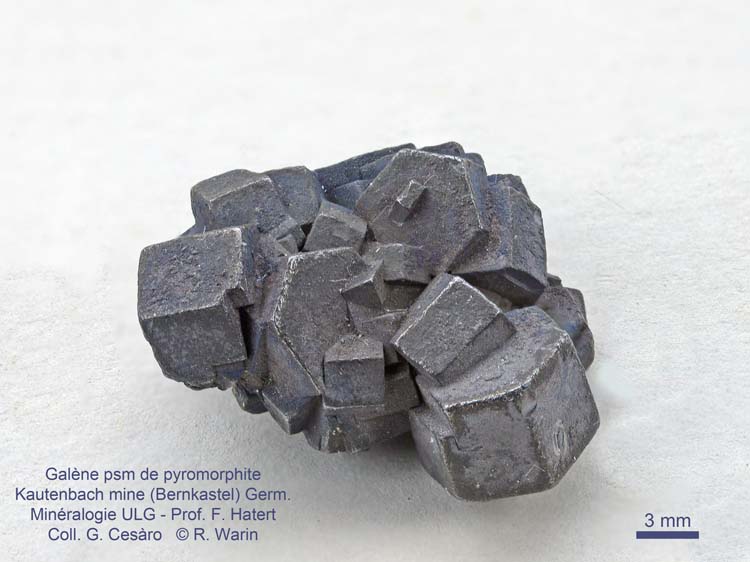
|
|
|
| Back to top |
|
 |
Tobi
Site Admin
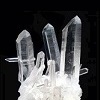
Joined: 07 Apr 2009
Posts: 4251
Location: Germany



|
 Posted: Feb 23, 2014 04:09 Post subject: Re: Collection of Giuseppe Cesāro (1849 - 1939) Posted: Feb 23, 2014 04:09 Post subject: Re: Collection of Giuseppe Cesāro (1849 - 1939) |
|
|
| I really enjoyed the last two German galenas from Freiberg (wonderful matrix specimen) and from Kautenbach Mine! The last one (called "Blaubleierz" in German, meaning "blue lead ore") is a really fine one. I actually don't like pseudomorphs (please don't hate me for saying this), but those hexagonally looking galenas are the only pseudomorph i would like to have in my collection :-)
|
|
| Back to top |
|
 |
Roger Warin

Joined: 23 Jan 2013
Posts: 1248



|
 Posted: Feb 23, 2014 13:46 Post subject: Re: Collection of Giuseppe Cesāro (1849 - 1939) Posted: Feb 23, 2014 13:46 Post subject: Re: Collection of Giuseppe Cesāro (1849 - 1939) |
|
|
Me too, Tobi.
These pseudomorphs don't come from Freiberg.
Roger.
|
|
| Back to top |
|
 |
Tobi
Site Admin

Joined: 07 Apr 2009
Posts: 4251
Location: Germany



|
 Posted: Feb 23, 2014 14:05 Post subject: Re: Collection of Giuseppe Cesāro (1849 - 1939) Posted: Feb 23, 2014 14:05 Post subject: Re: Collection of Giuseppe Cesāro (1849 - 1939) |
|
|
| Roger Warin wrote: | Me too, Tobi.
These pseudomorphs don't come from Freiberg.
Roger. |
I know, that's why i said "i really enjoyed the last TWO German galenas from Freiberg AND from Kautenbach Mine ;-)
Tobi
|
|
| Back to top |
|
 |
|





